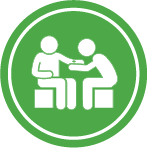Helping to keep people with dementia safe in their homes and communities sometimes requires the use of tools like locating technologies.
Devices like GPS trackers, radio frequency trackers, door sensors/alarms or cell phones can help to fulfill two main needs:
There are benefits and drawbacks to using locating technologies. Some people with dementia may prefer the personal freedom and safety they provide, while giving their caregivers peace of mind. Others may feel that locating technologies are an invasion of privacy. Factors like cost, ease of use, and tracking limitations may provide other challenges to using locating technologies.
Read below to learn more about locating technology options, and click Learn More to visit an external product site that will allow you to view locating technologies from choice vendors – learn about available devices, compare products, and find out which one might be right for you or the person with dementia that you’re supporting.

At Home, travelling with known carer, day program.
No technology needed at this stage
No technology is needed at this time, but it’s important to have a plan for the future. What agreements can be made about how the person with dementia can remain active in their community while acknowledging that their risk of going missing may change? Now is a great time to have that conversation.
Learn MoreFound and connected to primary caregiver. Goes out with carer.
Technologies that can be used at this stage include Medic Alert.
Technologies that can be used at this time include a cell phone or MedicAlert.
With MedicAlert, critical medical information and a hotline number is engraved on an ID bearing the MedicAlert symbol recognized by emergency responders. When the hotline number is called, 24-hour Emergency Hotline specialists immediately notify caregivers or family to let them know the situation and location of the member.
Learn MoreSundowning period (or time of day with most agitated energy).
Technologies include door sensor or alarm and video surveillance.
Technologies that can be used at this time include door sensors/alarms or video surveillance.
Door sensors or alarms are placed on or near a particular door, and will send out an alarm when the individual has opened the door. Pressure mats will send out an alarm when the individual is out of their bed or leaving the room. Video surveillance can send out an alarm when the individual is within a set location.
High risk period, search and rescue, possible life threatening.
Technologies that can be used include tracking device and first responders.
Technologies that can be used at this time include tracking devices (i.e. GPS, radio frequency, bluetooth) and first responders.
Global Positioning System (GPS) identify a person’s location using a transmitter that sends a signal to a network of telecommunicati
Radio Frequency (RF) identifies a person’s location using a transmitter that emits radio waves, which can be picked up by an antenna. Compared to GPS, the nature of radio waves limits their use to relatively small geographic areas (CADTH, 2016).
Bluetooth: Provides supplemental location when GPS signals are not available. Some devices enable users to assign a specific name such as front door to provide textual location information.
Learn More|
|
You may like to learn more about “Interacting with a person with dementia who may be lost” in one of our four – 15 minute Online Learning modules |
learn more |
